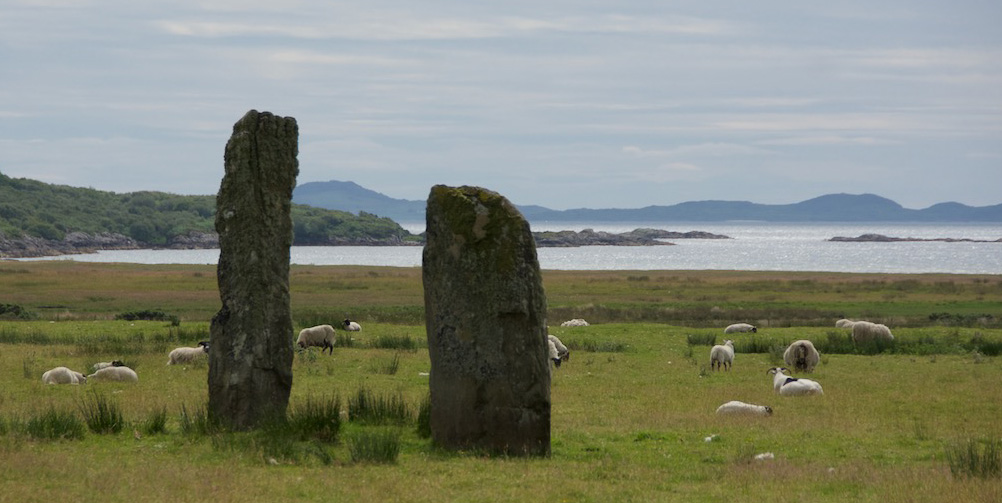
A folk tale, a battlefield, and a witch’s leap
I ought to know by now that if I glance through the car window and see some standing stones in a field, there’s going to be a story attached. Getting out and taking a couple of pictures, and then moving on, is never enough. You get back home, look them up, find a place-name, then a battle site… and you realise that you should have photographed a third stone, skulking in the next field, as well as an old graveyard about a hundred yards away, and a reputedly haunted rocky outcrop about half a mile down the road.
There’s only one solution: you’ve got to go back. So that’s what we did, yesterday. But I think the story had better come first…
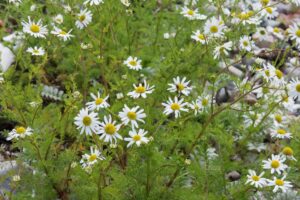 Sometime before 1490 (maybe even centuries before!) a young lad named McVicar was tending to his mother’s cow near Brenfield on the shore of Loch Fyne. A party of cattle-raiders passed by, and he spied on them, taking note of where they were heading. According to one story, the raiders were MacAllisters from Tarbert, while another version says they were MacNeills from the Isles. The old maps record them as Campbells. Whoever they were, they had been stealing cattle from the MacIvers of Glassary, who were kinsmen of the lad’s mother. He lost no time in running home and raising the alarm.
Sometime before 1490 (maybe even centuries before!) a young lad named McVicar was tending to his mother’s cow near Brenfield on the shore of Loch Fyne. A party of cattle-raiders passed by, and he spied on them, taking note of where they were heading. According to one story, the raiders were MacAllisters from Tarbert, while another version says they were MacNeills from the Isles. The old maps record them as Campbells. Whoever they were, they had been stealing cattle from the MacIvers of Glassary, who were kinsmen of the lad’s mother. He lost no time in running home and raising the alarm.
The MacIvers were known as the ‘Shaggy Black Horses of Glassary’, and they weren’t best pleased. Cattle raiding was rife between clans, and besides the insult to their pride, the loss of livestock inflicted hardship and starvation on families. Quickly gathering a band of vengeful warriors, they galloped off in pursuit, with the young lad as their guide. They were armed to the teeth, and they’d also had the forethought to bring along the ’wise woman’ of the clan, a witch whose powerful sorcery was only effective while she was mounted on horseback.
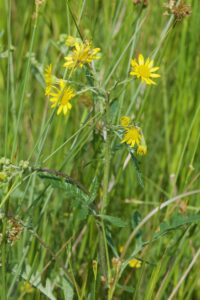 They followed the raiders’ tracks through Stronachullin and along the old drove-road over Sliabh Gaoil; then they headed south-west, skirting low rocky hills and isolated lochans until they caught sight of their quarry at a little place named Carse, where the Learg an Uinnsinn river empties into Loch Stornoway. Here they fell on the cattle raiders with unbridled fury. In the heat of the battle, the MacNeills (or MacAllisters, or Campbells!) recognised the witch and yanked her rudely from the saddle. Panick-stricken, the MacIvers yelled, ‘Cur a’Chailleach air a capull!’ (‘Get the old one back onto her mare!’)
They followed the raiders’ tracks through Stronachullin and along the old drove-road over Sliabh Gaoil; then they headed south-west, skirting low rocky hills and isolated lochans until they caught sight of their quarry at a little place named Carse, where the Learg an Uinnsinn river empties into Loch Stornoway. Here they fell on the cattle raiders with unbridled fury. In the heat of the battle, the MacNeills (or MacAllisters, or Campbells!) recognised the witch and yanked her rudely from the saddle. Panick-stricken, the MacIvers yelled, ‘Cur a’Chailleach air a capull!’ (‘Get the old one back onto her mare!’)
But it seemed that the wise woman had other ideas. Perhaps she sensed imminent defeat, or maybe she’d had enough of being used as a battle-witch! Leaping back onto her horse, she galloped away from the mayhem and fled westwards, halting atop a rocky knoll with sweeping views southwards towards the Sound of Gigha. Here, with the sea yawning below her, she leapt and was gone…
Meanwhile, down on the shore, the MacIvers knew that fortune had deserted them but they were fighting grimly on. By this time, other people had got involved: an onlooker, a MacNab, was pursued by four attackers and only saved himself by leaping across a gorge. At least one head had been lost, because the victors later proudly washed it in a river pool known as Slochd na Cinn, ‘the Pool of the Head’.
The young McVicar lad escaped with his life, but it was said that he became an outcast, living in an old fort known as the ‘robber’s den’ above Ardrishaig. He was a menace to his neighbours so one night his thatch was set alight and he was killed while trying to escape. Meanwhile, in a place where the calls of oystercatchers and curlews float up from the ebbing tide, the MacIver clansmen were buried. Standing stones were said to mark their graves.
That’s the story, and it would probably not have survived at all, if it wasn’t for the diligence of a local historian, Miss Marion Campbell of Kilberry, who published it in ‘The Kist’, the Magazine of the Natural History and Antiquarian Society of Mid-Argyll, in 1974. Miss Campbell was fascinated by archaeological remains, but she also had an ear for the folklore of her homeland.
 The standing stones that I caught sight of from the car window are tall and impressive-looking, even from a distance; up close, they are sparkly with mica and liberally plastered with lichen. The taller of the two is shot through with a thick vein of white quartz, and both have patches up to about knee-height that have been rubbed smooth by the sheep.
The standing stones that I caught sight of from the car window are tall and impressive-looking, even from a distance; up close, they are sparkly with mica and liberally plastered with lichen. The taller of the two is shot through with a thick vein of white quartz, and both have patches up to about knee-height that have been rubbed smooth by the sheep.
In the next field stands a third stone, slightly shorter and slimmer. It isn’t noticeable from the two-stone field because of a line of trees, but when we returned a few days later we walked all around it. An area of ground immediately to the south-west of it looks slightly raised, and the way the grass is growing makes me wonder if something lies beneath the surface.
These stones most likely date from the Neolithic or Bronze Age, in common with many other sites that are sprinkled around Knapdale and up into Kilmartin Glen. It’s an exaggeration to say that every field has one, but only just. They can’t be medieval grave markers. So where do the fallen MacIvers lie?
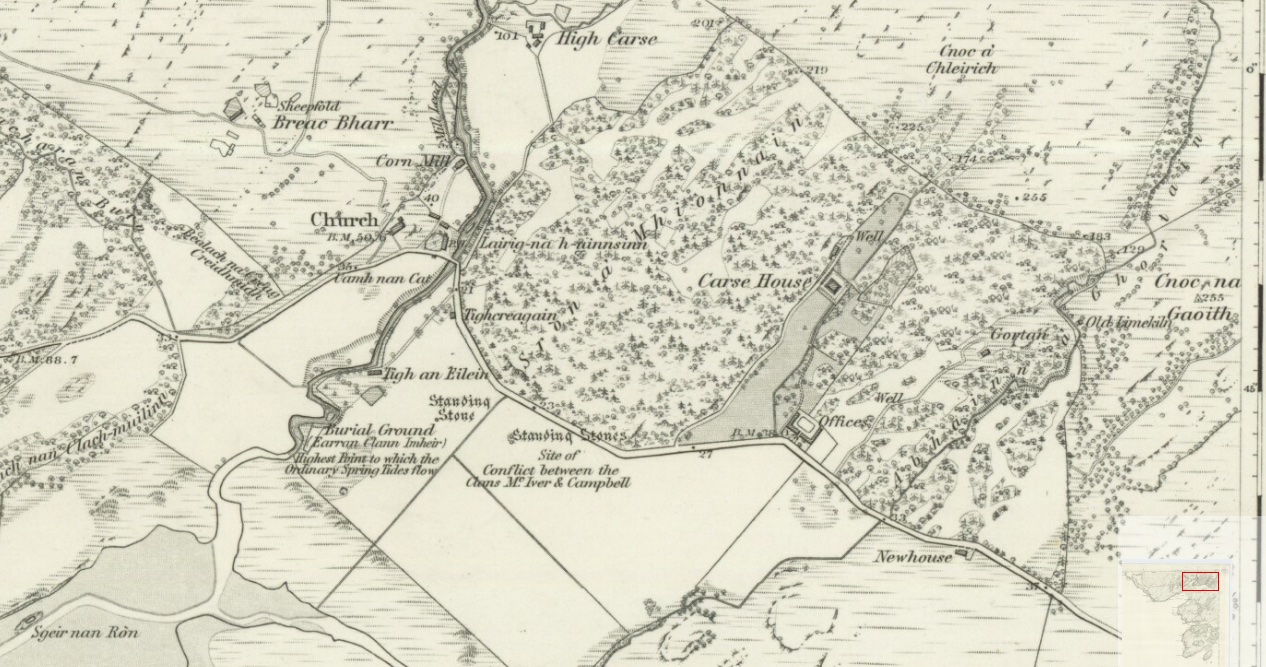 The OS Map of 1873 (6”, 1st Edition) shows a site called Earran Clann Imheir – the burial ground or ‘portion’ of the MacIvers. It lies a couple of hundred yards to the south of the single stone, and we reached it by walking through a patch of long grass and bracken. Enclosed by a low mossy wall, it is bounded on one side by the fast-flowing river, which was dark and peaty after days of heavy rain. Loch Stornoway glimmered in the distance.
The OS Map of 1873 (6”, 1st Edition) shows a site called Earran Clann Imheir – the burial ground or ‘portion’ of the MacIvers. It lies a couple of hundred yards to the south of the single stone, and we reached it by walking through a patch of long grass and bracken. Enclosed by a low mossy wall, it is bounded on one side by the fast-flowing river, which was dark and peaty after days of heavy rain. Loch Stornoway glimmered in the distance.

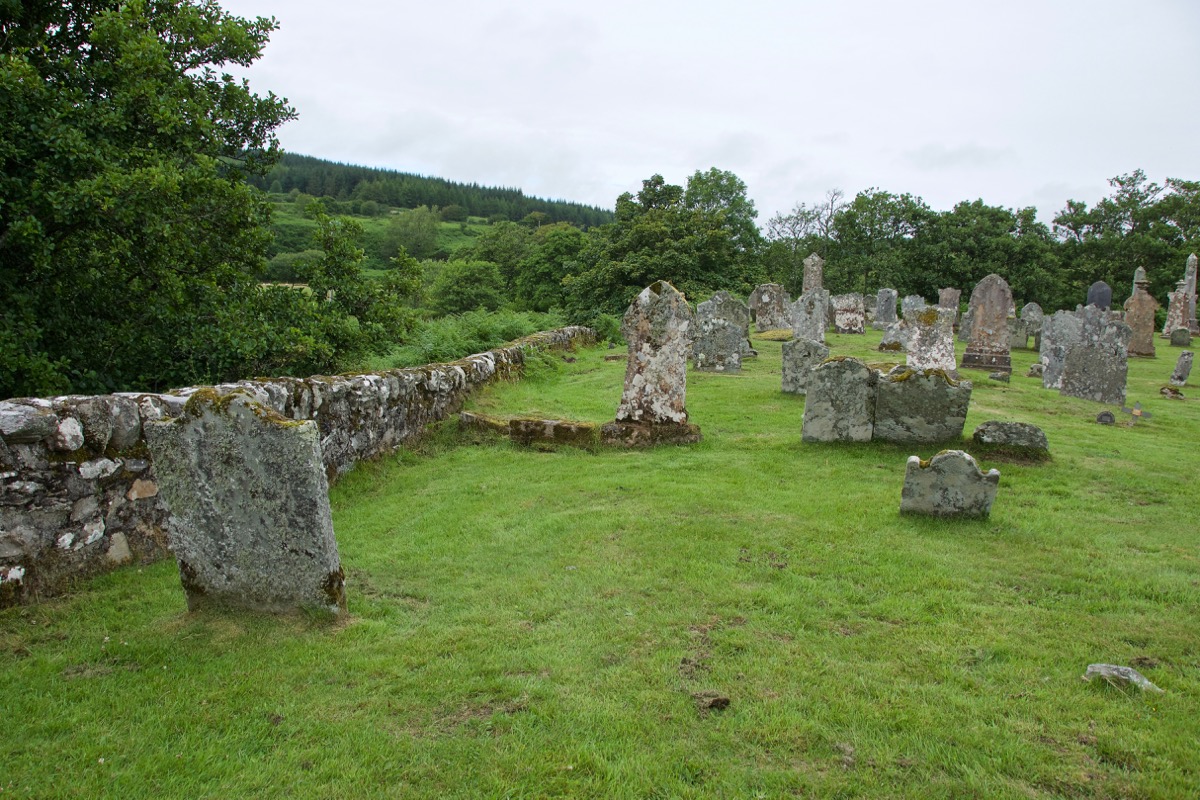
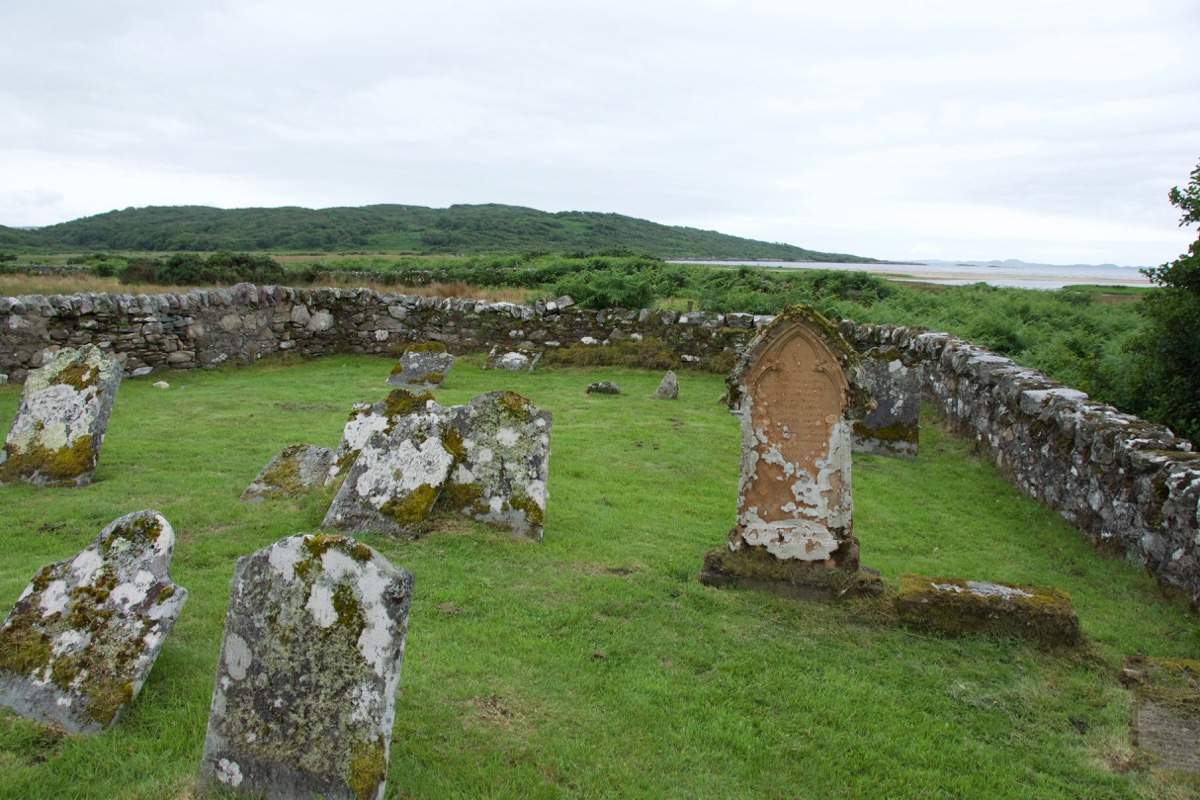 Some of the graves were relatively recent, but many of the inscriptions were weather-worn and illegible. From the variety of Highland names, it was immediately obvious that this site is not exclusive to the MacIvers, even if they might have been the first burials. It is – or was – a parish burial ground. There is no sign of any chapel having existed here, which is unusual for an old site such as this. And something else: three of the stones looked to me more like standing stones than grave markers, with their irregular shape and rough edges. Just how old are these?
Some of the graves were relatively recent, but many of the inscriptions were weather-worn and illegible. From the variety of Highland names, it was immediately obvious that this site is not exclusive to the MacIvers, even if they might have been the first burials. It is – or was – a parish burial ground. There is no sign of any chapel having existed here, which is unusual for an old site such as this. And something else: three of the stones looked to me more like standing stones than grave markers, with their irregular shape and rough edges. Just how old are these?
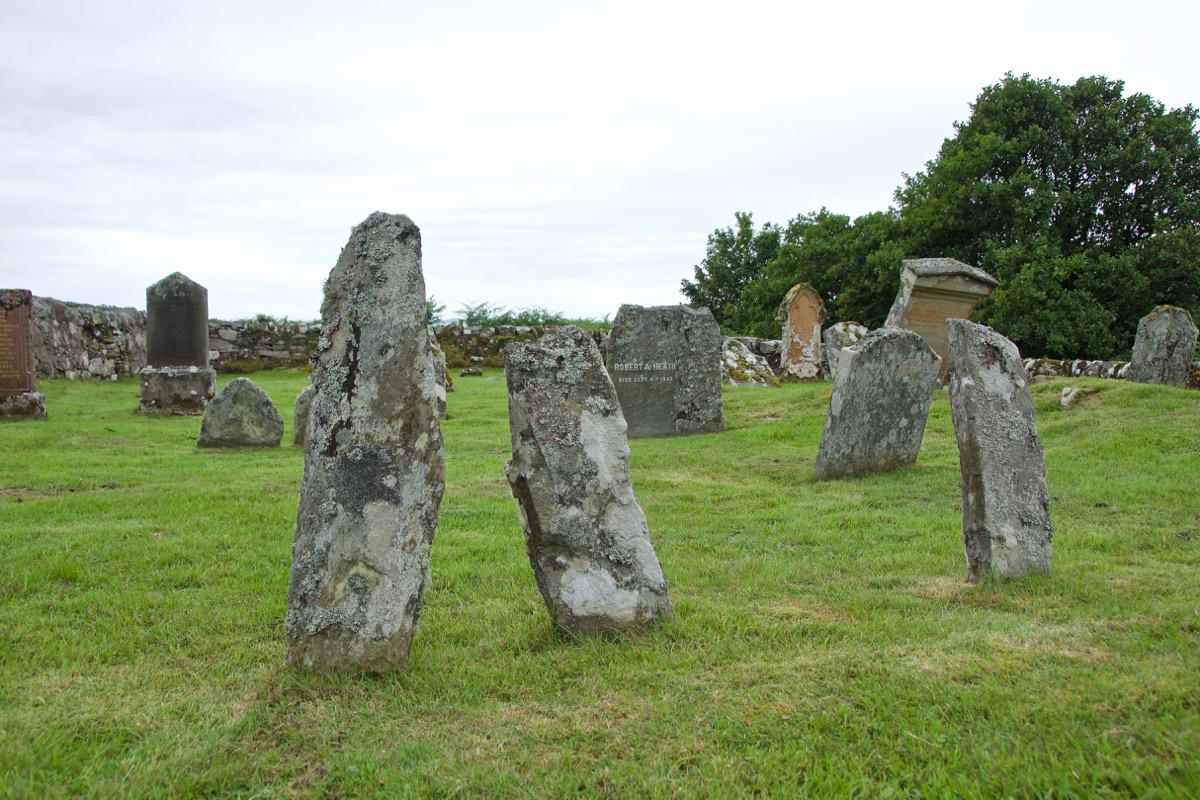 Miss Campbell’s theory is that there may well have been prehistoric burials here, and the story of the MacIvers and the cattle raiders may have been overlaid onto a much older tradition. She says: “If prehistoric graves were known, their area may well have been chosen for the parish graveyard, opened about 1720, since local feeling would oppose any other use for the ground.” Apparently, in the mid-1800s, the river in spate exposed a great number of skulls and bones near the north-east corner of the graveyard, which were assumed at the time to be evidence for the ‘buried warriors’ theory. Around the same time, some men draining the fields unearthed portions of thin plates of bronze, perforated and embossed with chevron patterns. Miss Campbell searched for them in a museum store-room, and was dismayed to find that they had completely disintegrated.
Miss Campbell’s theory is that there may well have been prehistoric burials here, and the story of the MacIvers and the cattle raiders may have been overlaid onto a much older tradition. She says: “If prehistoric graves were known, their area may well have been chosen for the parish graveyard, opened about 1720, since local feeling would oppose any other use for the ground.” Apparently, in the mid-1800s, the river in spate exposed a great number of skulls and bones near the north-east corner of the graveyard, which were assumed at the time to be evidence for the ‘buried warriors’ theory. Around the same time, some men draining the fields unearthed portions of thin plates of bronze, perforated and embossed with chevron patterns. Miss Campbell searched for them in a museum store-room, and was dismayed to find that they had completely disintegrated.
 While we were looking at the single stone, Colin noticed a narrow path snaking its way across the field. A sheep track, perhaps, but what was strange was that it appeared to originate at the stone, and to lead in the direction of the graveyard. In ‘The Pattern of the Past’ (1969) the accomplished dowser Guy Underwood says: “Cattle and other farm animals follow regular tracks when passing from one part of a field to another. Such routes almost invariably coincide with geodetic track lines, and very occasionally with aquastats.” (An aquastat is a name which he applies to a particular type of geodetic line).
While we were looking at the single stone, Colin noticed a narrow path snaking its way across the field. A sheep track, perhaps, but what was strange was that it appeared to originate at the stone, and to lead in the direction of the graveyard. In ‘The Pattern of the Past’ (1969) the accomplished dowser Guy Underwood says: “Cattle and other farm animals follow regular tracks when passing from one part of a field to another. Such routes almost invariably coincide with geodetic track lines, and very occasionally with aquastats.” (An aquastat is a name which he applies to a particular type of geodetic line).
So, what on Earth can we make of all this? Has the battle tale been blended with something much more ancient? Were the first graves here Neolithic ones? And what happened to the old woman who leapt off the cliff?
Miss Campbell, who lived at Kilberry all her life, says that the crag of the leap was known locally as Creag a’Stars, possibly from stairsneach, a step or threshold. As a historian, she believed that the woman on horseback was “none other than Epona herself, the Horse-goddess of Kintyre and of Roman Gaul.” In other words, a Celtic goddess was dimly remembered in a folk tale of much later date. This may have been so, but just to the east of the crag was Slochd na Chapuill, ‘the hollow of the horse,’ and it was notoriously haunted. The young carters whom Miss Campbell knew as a girl would dread going through there because it spooked their placid Clydesdales, and she herself admits that it was always best to dismount and lead a pony through it. It is curious, looking at the OS map of 1890 (6″, 2nd Edition), to see how the old road makes an abrupt detour to avoid the crag (visible far left, in the above map). The newer road, of course, passes directly beneath it. We whizz past, oblivious of old ghosts.
Miss Campbell records an old tradition, that passers-by would throw a pebble and try to lodge it on a little ledge on the cliff-face. Three goes were allowed, and if you were successful you were granted a wish. Colin and I were amazed to see this ledge, which is still strewn with rounded pebbles. Yes, we each got a pebble up there, and made a wish!
Creag a’Stars, showing the ledge (above, top left) and below, close-up
This story has grown more arms and legs than usual, and that’s saying something. One last note, because I love place names. The hill immediately above the two-stone field is called Sron a’Mhionnain, or ‘Cursing Nose,’ and below it stood Clach a’Bhreitheamh, ‘the Judge’s Stone.’ Tradition tells how condemned criminals were hurled from the top. Miss Campbell says that the judge’s ‘chair’, a natural rocky seat, was broken up around 1892 for road-building.
The hill called Sron a’Mhionnain, or ‘Cursing Nose,’ behind the two stones
Some places are so thick in folklore that you’re practically wading through it. These stories have been perpetuated by generations of storytellers who reworked and embellished them, so that they never grew stale with the telling. They add an extra dimension, an unseen layer to our landscape, and I think that’s why I love them. I can only echo the words of Miss Campbell, who loved them too: “Let a modern practitioner of the art lay a stone on the old master’s cairn and salute his spirit.”
References:
- ‘The Kist’ (Natural History and Antiquarian Society of Mid-Argyll) no.8, 1974: ‘The Battlefield of Carse’ by Miss Campbell of Kilberry
- Canmore database: Standing stones, battlefield and graveyard
- National Library of Scotland maps
Images © Colin & Jo Woolf

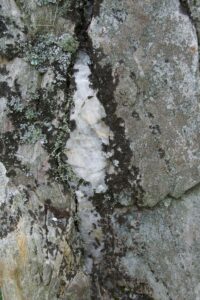
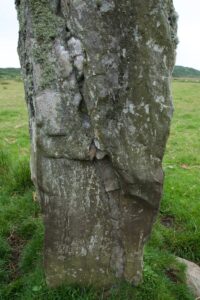


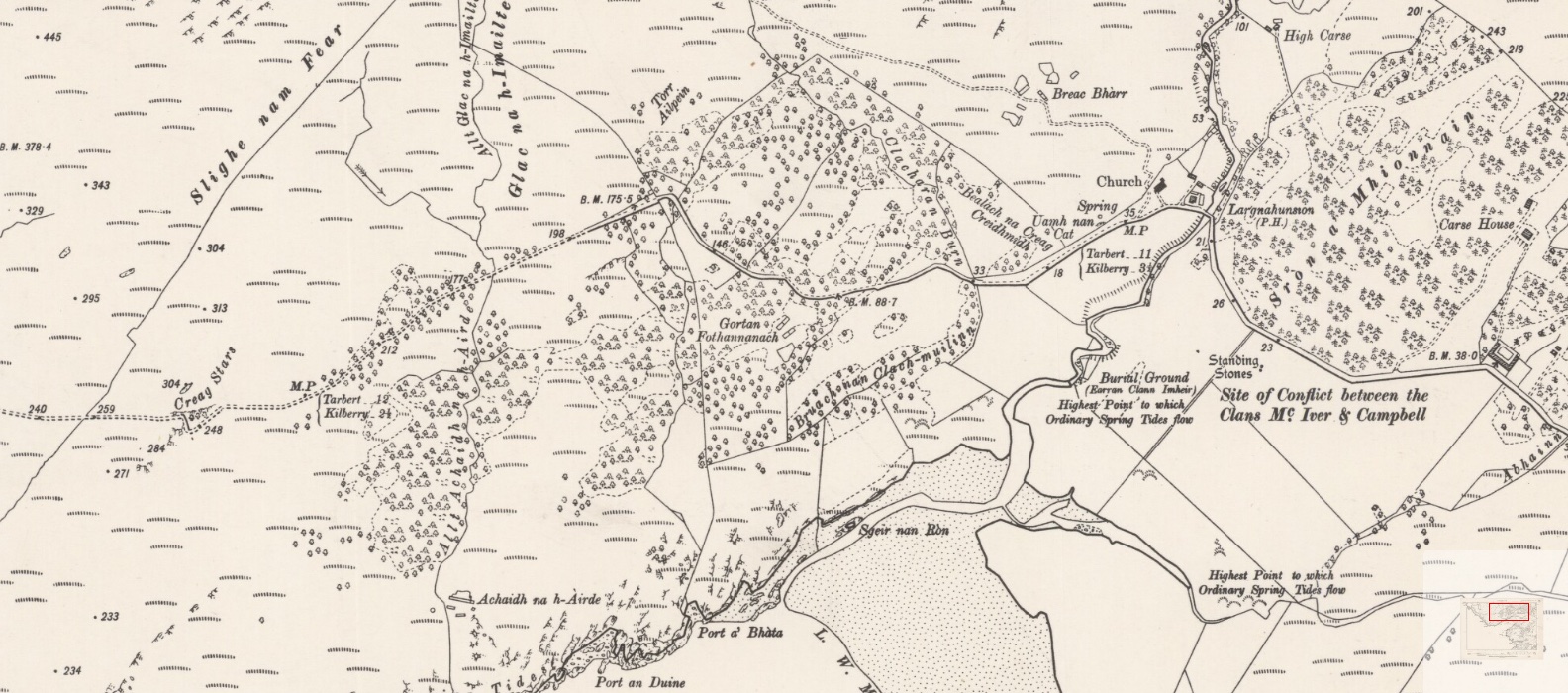



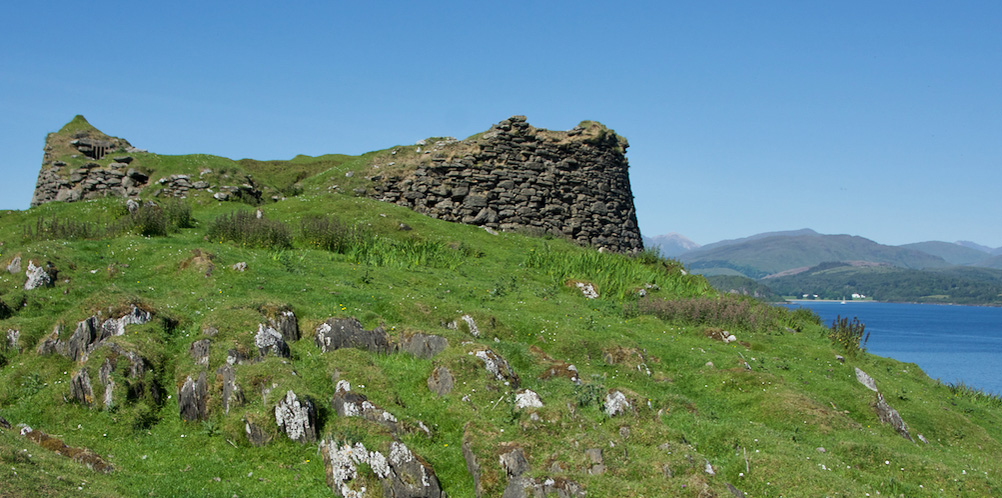
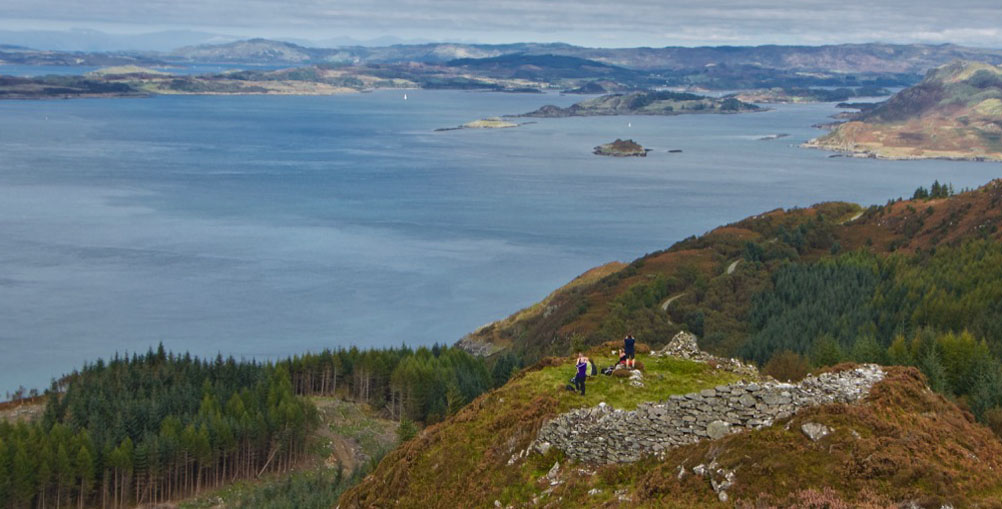
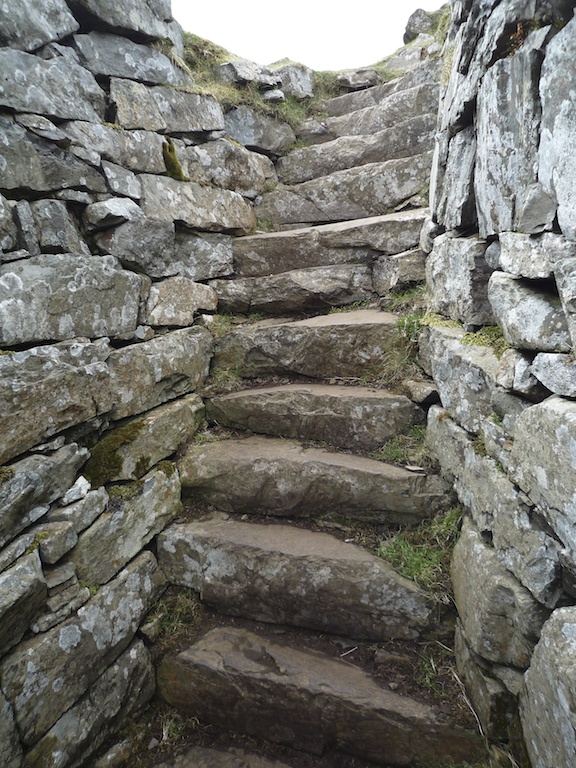
24 Comments
sulewath
Fascinating.
Jo Woolf
Yes, isn’t it? I’m still amazed at how many of these stories there are!
Ashley
I’m sure that if any of us 21stC people had lived in the 15thC we wouldn’t have lasted 5 minutes! Too soft! The stories are gruesome; I suppose we should be glad that we don’t live like that anymore!
(Marion Campbell is quoted in so many of Jim Crumley’s books. Have you read any of his books?)
Jo Woolf
Very true, and I’m often grateful, haha! Yes, I love Jim Crumley’s work. I’m also enjoying Philip Marsden’s ‘Rising Ground’, and very much enjoyed his latest work, ‘The Summer Isles’.
davidoakesimages
What a great story…. fact and fiction as you well know, often get mixed together and some times the truth lost in the mix. Now that’s a story worth making a film about as good as any Rob Roy. ?
Jo Woolf
It certainly is, David! They did know how to spin a yarn in those days. Life was dangerous but very dramatic!
greg-in-washington
I am pretty much home bound by my own design and I really enjoyed you setting my imagination free and showing the fascinating landscapes and stories. ?
Jo Woolf
In that case, I’m delighted that you can travel here in your imagination! There are endless places to explore round here and it’s always a pleasure to find out about their stories.
Finola
What a marvellous story – or series of stories. You certainly don’t “whiz past, oblivious.” I am sending the post to my Irish conversation group, as an example of how similar Irish and Scots Gaelic are – I easily understood all your place names. Finally, I was struck by bhow similar your lead in to the post was to Robert’s today (Signal Towers 3 post) – we are similarly motivated, it seems.
Jo Woolf
Thank you, Finola! I’ve just read Robert’s article and wholeheartedly agree with him! I wish it every time I go out. Delighted to know that you can understand the place-names – proof of how much connection there was in former times. I noticed also, on the next map sheet to the NW, a ‘Bealach Sithe’, ‘Cnoc Bealach Sithe’ and ‘Colbh Sith’ – I guess the first two might be ‘pass of the fairies’ and ‘knoll of the pass of the fairies’ but I don’t know what the ‘Colbh’ might be. There’s some old magic around there, for sure!
Finola
Colbha in Irish means outer edge or ledge – could be it? Bealach usually means a way or a track rather than a pass. But either way, these spots belong to the Sí!
Jo Woolf
Could well be that! Sounds like a very magical place!
Bob Hay
Engrossing article Jo. Your writings remind me of Seton Gordon that great collector of Highland lore.
Keep them coming.
Jo Woolf
Thank you very much, Bob! That’s lovely to know. I’m sure there are plenty more stories to be discovered!
dancingbeastie
Marvellous tales, vividly told. Mid-Argyll is like nowhere else I know for wading knee-deep in folklore!
Jo Woolf
Thank you – they really tell themselves, they’ve got such energy! That’s what I love about Argyll. Nice to hear from you, and hope you’re all well.
Bob Hay
Every hill, loch, stream, shore, glen, wood in Argyll has a story.
Jo Woolf
That’s so true! Stories are just woven into the landscape.
Ashley
No matter where we walk on this earth, someone has probably already trodden there before us! I’ve always had a notion that with every step we take we are walking on the bones of our ancestors!
Jo Woolf
I know, Ashley, I say the same thing, or along those lines, pretty much all the time, and it’s especially tangible around here. Everyone has walked these tracks, stood on these hills, and they knew the landscape far better than we do.
Ashley
Just think of all the stories under our feet that lie untold! It’s a bit like our ancestral DNA, which is amazing, but we’re unable to ‘know’ them, so it remains in the spiritual realm! Sorry! I’d better stop there before I’m carried off!
Jo Woolf
Haha, I know!! It’s all there somewhere, if we could grasp it!
Robert Turner
Thanks Jo. What a spectacular storey.
Jo Woolf
Glad you enjoyed it, Robert! Makes me wonder about all the other stories out there…